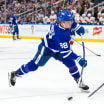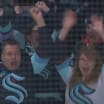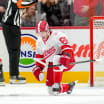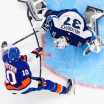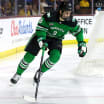Editor's note: Lindsay Berra is a national correspondent for MLB.com. She played varsity softball and men's club ice hockey at the University of North Carolina and is an avid CrossFitter, hiker, cyclist and yogi. She worked out with Jason Zucker of the Minnesota Wild last month in Las Vegas.
LAS VEGAS -- "We all want air," Steve Chayra says. "How far can you push without air?"
During the offseason, Minnesota Wild forward Jason Zucker has been testing that limit physically and mentally as he prepares for this season. The question is on my mind as I let all the air out of my lungs and, while holding that exhalation, follow Zucker on a walk past the benches, squat racks, heavy bag and boxing ring, down to the mirrors on the other end of the gym before turning around and coming back.
Inside look at Wild forward Zucker's offseason training
NHL.com works out with Las Vegas resident, who is coming off core muscle surgery

© Bruce Kluckhohn/Getty Images
Zucker's pace is slow and smooth. I resist the urge to run and instead try to mimic his stride. My lungs start to burn. My body heats up. My brain says, "Breathe!" but I fight it, and I make it all the way back to the doorway, where Chayra waits.
"There are a lot of lessons from what I've done, as a college athlete and serving in an elite unit in the military," says Chayra, a former Navy SEAL. "I take those lessons and I dilute them and see how people can apply them in their own lives. I make challenges in here, in the safe, comfortable environment of the weight room, and show people there is more inside them than they realize."
Zucker, 25, began training with Chayra at Red Road Training in his hometown of Las Vegas three years ago. They work out three times a week in the gym and once each in the pool and on the field. The goal, of course, is to make Zucker stronger physically, but Chayra is also focused on increasing Zucker's mental capacity to push himself.
When Zucker had bilateral core muscle surgery in May, strengthening his midsection from the inside out also became a priority. So Chayra, a devotee of Wim Hof, who teaches breathing techniques that can increase energy and focus, reduce stress and influence the nervous system, added breathing exercises to Zucker's program.
"I feel doing all the breathing techniques this summer has really benefited me physically and mentally, and I feel it's something that's going to benefit me on the ice and off the ice, too," Zucker says. "I use them before I go to sleep and wake up, on a six- or seven-day-a-week basis. It really has helped me a lot."
The well-practiced Zucker remains composed as we do more and more activities without air: falling backward onto the floor, then standing with no hands, then diving forward rolls. My body gets hotter and, at one point, the entire room looks pink, but I survive the "warmup" and move on to the remainder of Zucker's full-body workout.
Zucker had a plus-34 rating last season, tied with Wild defenseman Ryan Suter for the League lead. Zucker had 47 points (22 goals, 25 assists) in 79 games, more than doubling his total from the previous season, when he had 23 (13 goals, 10 assists) in 71 games. He wants those numbers to keep improving, so he had very specific gym goals this offseason.
"I told Steve I wanted to make sure that when I take little hits in the corners I'm really strong and I don't get knocked off the puck," Zucker says. "That's a lot of lower body, glutes, core and lower back, so when I take those little bumps from defensemen I'm not getting hit off the puck as easily as I have been in the past."
To that end, we begin with kettlebell double squats linked with a breathing rhythm to fully engage the abdominal wall. (If you've never seen a kettlebell, it's a cast-iron ball-shaped weight with a handle). We follow with a couplet of one-arm seated kettlebell floor presses (a pushing exercise) and ring rows with our feet elevated on a box (a pulling exercise).
"Agonist and antagonist movements, a push and a pull, one side of the body at a time," Chayra says. "It's a great way to get strong. It's very taxing on the body, but it's a very efficient way to train because there are a lot of demands on the body and many different muscles are moving at once."
Then we put on weight vests for an exercise Chayra designed to mimic the skating stride, with one foot planted on a step and the other moving into a lunge at a 45-degree angle while on a sliding stability disc.
"The stride was something I was really feeling when my injury happened," says Zucker, who skates twice a week in July and three or four times each week in August. "I wanted to make sure that the 45-degree stride in the gym was strong so I could simulate that on the ice."
We finish with a triplet of plank marches on a Bosu ball, Pallof presses on the cable machine and side crunches off a bench for the abdominals. Though the breathing exercises pushed me far past the edge of my experience, I am familiar with all of these more traditional gym exercises and I feel comfortable as we wrap up workout Day One and move into Day Two.
That comfort doesn't last long, though, as we wake up to a rare rainy morning here. The grass is long on the field where Zucker and Chayra do their sprint workouts -- Chayra likes it that way because it makes running more difficult -- and today, the grass is also wet and slick. Zucker is prepared with soccer cleats but I have to make do with my flat-bottomed running shoes. Chayra is also making do; Zucker forgot his orange field cones, so Chayra scatters Zucker's Birkenstock sandals, our water bottles and a bottle of sunblock across the field in lieu of the cones.
We warm up with lunges, squat jumps, high knees, side shuffles and some graduated sprints. After that, we do cone drills to work on explosively changing direction, accelerating and decelerating, sprinting sideways, backwards and straight ahead. We finish with the biggest challenge of the two days: a gasser of a sprint test that mimics the stop-and-start, goal-line-to-goal-line skating test Zucker will have to perform when he arrives at training camp.
"It's basically 55 yards down and back four times," Chayra says. "We rest for 90 seconds and we do the whole thing five times. It's quite difficult, especially after all the change of direction and explosivity work we've already done in the grass."
I wholeheartedly agree. For Zucker, the goal is to complete each 220-yard test in less than 45 seconds. He easily lowers that to 37, while my time hovers around 42. But I complete all five tests -- to Chayra's surprise, I think -- and I'm generally pleased with myself.
Zucker, though, was hoping for more. The long, wet grass slowed him down a bit; his times were ever-so-slightly faster the previous week, and he wants to build on every workout the same way he builds on every hockey season.
"That's definitely the direction I want to keep going in," Zucker says. "I have never felt better. I don't know that I've ever been more excited or more ready for a hockey season."

